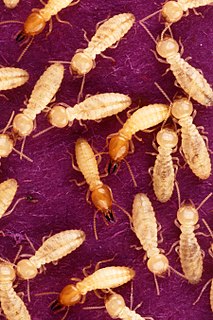
Termites are eusocial insects that are classified at the taxonomic rank of infraorder Isoptera, or as epifamily Termitoidae within the order Blattodea. Termites were once classified in a separate order from cockroaches, but recent phylogenetic studies indicate that they evolved from cockroaches, as they are the sister group to wood eating cockroaches of the genus Cryptocercus. Previous estimates suggested the divergence took place during the Jurassic or Triassic. More recent estimates suggest they have an origin during the Late Jurassic, with the first fossil records in the Early Cretaceous. About 3,106 species are currently described, with a few hundred more left to be described. Although these insects are often called "white ants", they are not ants, and are not closely related to ants.
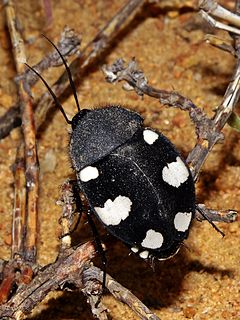
Blattodea is an order of insects that contains cockroaches and termites. Formerly, the termites were considered a separate order, Isoptera, but genetic and molecular evidence suggests an intimate relationship with the cockroaches, both cockroaches and termites having evolved from a common ancestor. The Blattodea and the mantises are now all considered part of the superorder Dictyoptera. Blattodea includes approximately 4,400 species of cockroach in almost 500 genera, and about 3,000 species of termite in around 300 genera.
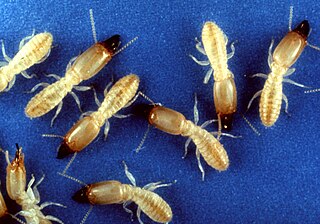
Reticulitermes flavipes, the eastern subterranean termite is the most common termite found in North America. These termites are the most economically important wood destroying insects in the United States and are classified as pests. They feed on cellulose material such as the structural wood in buildings, wooden fixtures, paper, books, and cotton. A mature colony can range from 20,000 workers to as high as 5 million workers and the primary queen of the colony lays 5,000 to 10,000 eggs per day to add to this total.

Mastotermes darwiniensis, common names giant northern termite and Darwin termite, is a termite species found only in northern Australia. It is the most primitive extant termite species.

Nasutitermes corniger is a species of arboreal termite that is endemic to the neotropics. It is very closely related to Nasutitermes ephratae. The species has been studied relatively intensively, particularly on Barro Colorado Island, Panama. These studies and others have shown that the termite interacts with many different organisms including a bat that roosts in its nest and various species of ants that cohabit with the termite.
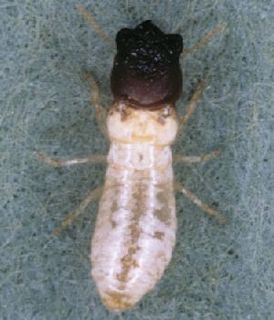
Kalotermitidae is a family of termites, commonly known as drywood termites. Kalotermitidae includes 21 genera and 419 species. The family has a cosmopolitan circumtropical distribution, and is found in functionally arid environments.

Zootermopsis angusticollis is a species of termite (Isoptera) in the family Archotermopsidae, a group known as the dampwood termites, or the rottenwood termites. As their name suggests, the dampwood termites can only survive by living off of wood that contains high amounts of moisture. They are found along the wet environments of the Pacific coast of North America. Most are found in the states of California, Oregon, Washington, Idaho, Western Nevada and in southern British Columbia. Termites are well known to be destroyers of wood, and although the dampwood termites can cause some damage, they are not as notoriously known to cause as much damage to buildings as the drywood termites. They occasionally have been carried to other parts of the country through wood shipments, but have not been able to become established in these areas due to undesirable environmental conditions.
Coptotermes gestroi, the Asian subterranean termite is a small species of termite that lives underground. Both this species and the Formosan subterranean termite, are destructive pests native to Asia, but have spread to other parts of the world including the United States. In Asia, this species is known as the Philippine milk termite.
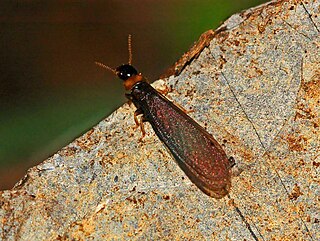
Kalotermes flavicollis, the yellownecked dry-wood termite, is a species of dampwood termites belonging to the family Kalotermitidae, one of the most primitive families of termites.

Mastotermes is a genus of termites. The sole living species is Mastotermes darwiniensis, found only in northern Australia. A number of extinct taxa are known from fossils. It is a very peculiar insect, the most primitive termite alive. As such, it shows notable similarities to certain cockroaches, the termites' closest relatives. These similarities include the anal lobe of the wing and the laying of eggs in bunches, rather than singly. The termites were traditionally placed in the Exopterygota, but such an indiscriminate treatment makes that group a paraphyletic grade of basal neopterans. Thus, the cockroaches, termites and their relatives are nowadays placed in a clade called Dictyoptera.

Reticulitermes is a termite genus in the family Rhinotermitidae. They are found in most temperate regions on Earth including much of Asia and the Middle East, Western Europe, and all of North America.

Incisitermes minor is a species of termite in the family Kalotermitidae known commonly as the western drywood termite. It is native to western North America, including the western United States and northern Mexico. It has been found in many other parts of the United States, all the way to the East Coast. It has been reported from Toronto. It has been introduced to Hawaii. It has been noted in China and it is not uncommon in Japan. This is an economically important pest of wooden structures, including houses. In California and Arizona alone its economic impact is estimated to be about $250 million per year.
Coptotermes acinaciformis is a species of subterranean termite in the family Rhinotermitidae native to Australia. Termites are social insects and build a communal nest. In the case of C. acinaciformis, this is either in the root crown of a tree or underground. From this, a network of galleries extends through the nearby soil, enabling the workers to forage in the surrounding area without emerging on the surface of the ground. This termite can cause substantial damage to trees and the wooden parts of buildings.

Cryptotermes brevis is a species of termite in the family Kalotermitidae, commonly known as the West Indian drywood termite or the powderpost termite. It is able to live completely inside timber structures or articles made of wood such as furniture without any outside source of water. It is frequently introduced into new locations inadvertently, and causes damage to the structural timbers of buildings and to wooden objects such as furniture.
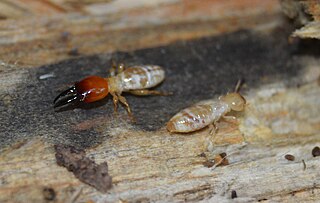
Zootermopsis is a genus of termites in the Dampwood termite family (Archotermopsidae). They are mostly found in western North America, ranging from Canada to Mexico, with the exception of Z. nevadensis, which has become established in Japan. They live in rotting wood, commonly inhabiting fallen or dead trees in North America's temperate rain forests, where they break down the wood's cellulose with the help of symbiotic protozoa and bacteria in their stomachs. The life and reproductive cycles of these termites are relatively normal compared to other members of its family. Species can be identified using the shape and position of the subsidiary tooth in all non-soldier castes, allowing a more certain identification than the previous method, which was based on the more ambiguous morphology of soldiers.
Marginitermes hubbardi, commonly known as the light western drywood termite, is a species of termite in the family Kalotermitidae. It is found in Central America and desert regions of southwestern North America.
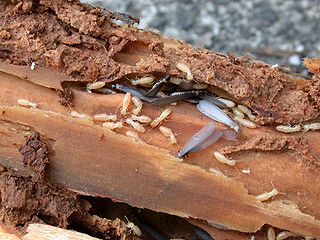
Reticulitermes speratus, the Japanese termite, is a species of subterranean termite found in Japan, North Korea, and South Korea. It eats decayed wood. It is adapted to withstand the cold temperatures of the temperate regions it inhabits.
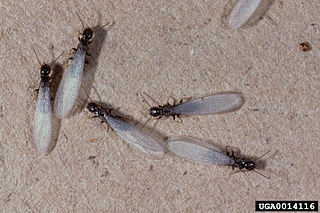
Reticulitermes virginicus is a species of subterranean termite native to North America, found often in the southern United States. It was described in 1907.
Pterotermes is a monotypic genus of termites in the family Kalotermitidae. Pterotermes occidentis is the single species in the genus. This termite lives in the extremely dry conditions found in the Sonoran Desert in southwestern United States, Baja California and Mexico. It feeds on dry wood and lives entirely within a single piece of timber.

Reticulitermes tibialis, the arid-land subterranean termite, is a species of termite in the family Rhinotermitidae. It is found in the United States, mostly in the western half, occurring in deserts, prairies and other dry locations.














